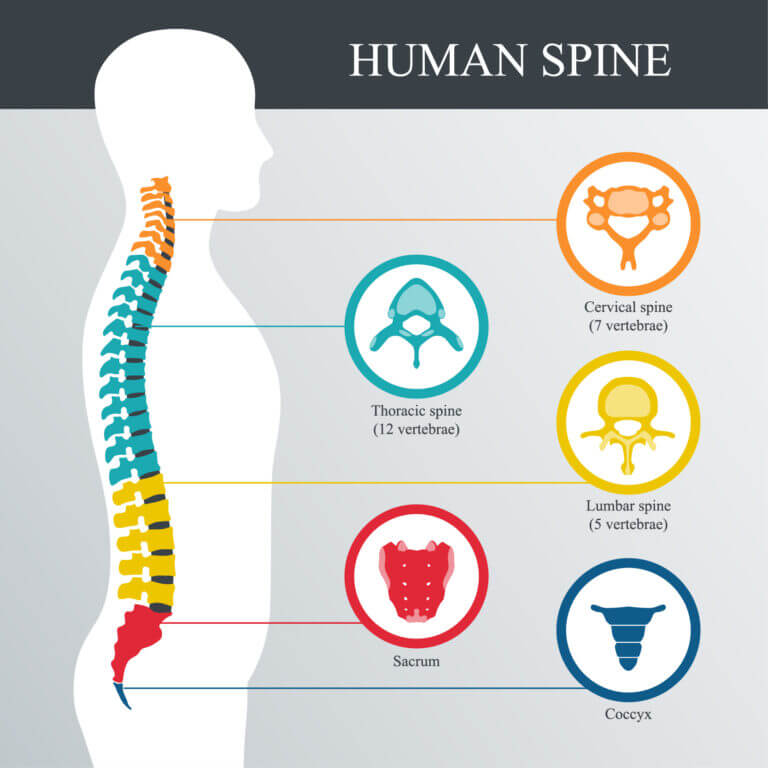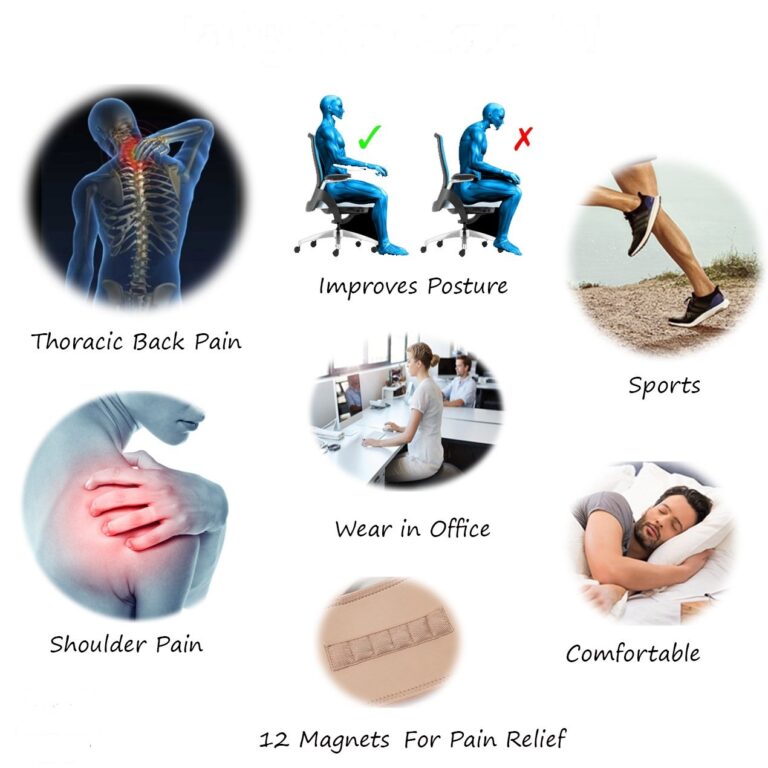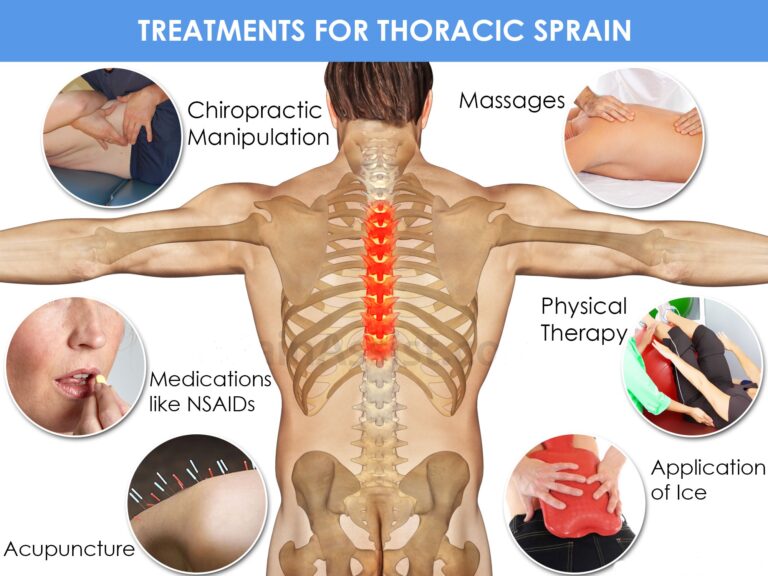WHAT IS THORACIC SPINE SYNDROME?
The upper back pain affects everyone differently, as there are various possible reasons for your upper back or mid back pain. One of the common reasons is thoracic spine syndrome.

The thoracic spine is the most complex and the longest region of the spine. The thoracic spine runs from the base of the neck to the abdomen that connects with the cervical spine above and the lumbar spine below. The thoracic spine consists of 12 vertebrae that sit between your neck bones and the bottom of your spine, which attaches to the rib cage. Thoracic spine syndrome is an umbrella term leading to the various reason for pain in your body.
Thoracic back pain may also lead to neck pain or low back pain. Thoracic back pain may be the result of serious spinal pathology but thoracic back pain is also prevalent among healthy individuals without any serious underlying cause.
WHAT LEADS TO THORACIC SPINE SYNDROME?
The most common cause of thoracic spine syndrome is poor posture, limited motion, and excessive strain. Sometimes, inflammation of the muscles or soft tissues of the thoracic spine also leads to pain. The inflammation can occur due to various reasons:
- Sprain or strain may be due to car accidents or sports injuries.
- Poor posture includes sitting or standing in a slouched position.
- Using a backpack.
- Sitting for a long time at a computer.
- Lack of muscular strength.
- Overuse injury.
- Narrowing of the spine or thoracic stenosis
- Wear and tear of the thoracic spine.
- Slipped discs.
- Fractures of the vertebrae.
- Osteoporosis.
- Spinal infection.
- Shingles.
- Spinal osteoarthritis.
- Ankylosing spondylitis or inflammation of the joints between the vertebrae.
- Scheuermann’s disease or inflammation of the joints of the spine results in spinal curvature.
- Spinal tumors.

Sometimes the thoracic spine pain is not originating from the spine itself but it can be due to various reasons including problems affecting the lung, the uppermost part of the gut (the esophagus), the stomach, the pancreas, and the gallbladder.
WHAT ARE THE COMMON SYMPTOMS OF THORACIC SPINE SYNDROME?
The pain in your upper back or thoracic spine region can be due to daily or weekend-warrior activity, you might experience:
- Pain in the lower back
- Pain radiating down the legs
- Tightness
- Stiffness
- Tenderness to touch
- Headache
- Incontinence (bowel and/or bladder leakage)
- Numbness or weakness in your legs
These are the most common symptoms of musculoskeletal strain. These can also occur along with spinal injury. In case of mild upper back soreness linked to an activity will not require you to rush to the doctor immediately. But, if you have upper back pain along with other symptoms, it’s important a call your doctor, such as:
- A recent serious injury like a car accident or a fall from a height.
- Minor injury or heavy lifting especially if you have osteoporosis.
- People under 20 or over 50 years when the pain initiates.
- Underlying causes like cancer, drug misuse, HIV infection.
- Use of steroids for a long time.
- Pain along with high temperature (fever), chills, and unexplained weight loss.
- Bacterial infection.
- Severe pain that is worsening.
- Pain not caused by a sprain or strain (non-mechanical).
- Pain not getting better after 2-4 weeks of treatment.
- Pain along with severe stiffness in the morning.
- Changes in the shape of the spine with visible lumps or bumps.
- Feeling like pins and needles, numbness, or weakness of the legs.
- Passing wee or poo accidentally due to pressure on the spinal cord.

ARE ANY TESTS REQUIRED TO DETECT THORACIC SPINE SYNDROME?
You may not require to visit a doctor or undergo tests if the pain is short-lived and mild with an obvious explanation. But, as the pain becomes severe, occurring in the thoracic area rather than in your neck or lower back, your doctor is likely to suggest tests.
The tests help the doctor to rule out other conditions for upper back pain. The tests usually include blood tests such as a full blood count and inflammatory markers, and maybe a magnetic resonance imaging (MRI) scan. Sometimes, an ordinary ‘plain’ X-ray will not provide much information unless you have an unusual appearance of the spine or a fracture is suspected.
WHAT IS THE BEST WAY TO TREAT THORACIC SPINE SYNDROME?
- Physical therapy – This is the most important pillar during the treatment for thoracic spine pain. Physical therapy aims to improve mobility by focusing on a decreased or abnormal range of motion. It also helps in decreasing pain and addressing any mechanical or muscular conditions such as postural abnormalities that may be present.
- Medication – OTC, as well as prescribed anti-inflammatory medications (ibuprofen, naproxen), acetaminophen (Tylenol), and muscle relaxants can help provide short-term relief of associated symptoms. Physical therapy along with medication makes it easier in addressing the thoracic spine pain.

- Injections – The doctor would recommend injections if the combination of physical therapy and medications doesn’t provide enough relief. The injections may deliver the long-term relief of symptoms you desire. The doctors would identify the most likely pain generators and deliver medication via injection to that area with the use of image guidance. These injections can be both diagnostic and therapeutic.
- Posture exercises – Poor posture is the major reason for thoracic spine syndrome. Good posture includes correctly aligned spinal structures, which reduces back strain. Regular exercises help correct posture such as:
- Chin tuck: This involves sitting in a chair with your feet flat on the floor. With your shoulders relaxed and down pull your chin in toward your neck and count to five, then relax. Repeat 10 times.
- Shoulder blade squeeze: This involves putting your hands on your thighs and keeping your shoulders down, roughly at chin level. Then slowly squeeze your shoulder blades together and count to five, then relax. Repeat three or four times.
- Upper back stretch: This involves raising your right arm to shoulder level, directly in front of you, then bending your arm at the elbow to grasp that elbow with your left hand. Now gently pull it across your chest and hold it for 20 seconds. Repeat three times on each side.
- Regenerative medicine – Regenerative medicine therapies include platelet-rich plasma (PRP) and stem cell treatments.
- Spinal Cord Stimulation – Spinal cord stimulation treatment is used in cases of refractory thoracic spine pain.
OUTLOOK
The prognosis for thoracic spine syndrome depends on the underlying cause, your age, and your general fitness. Often, many cases recover on their own in a few weeks. But, sometimes pain in the thoracic spine may affect the neck or lower back leading to a serious condition.
If you or anyone you know is suffering from upper back pain, our expert providers at Specialty Care Clinics will take care of your health and help you recover.
Call us on (469) 545-9983 to book an appointment with our specialists.
